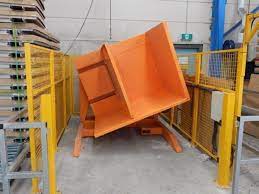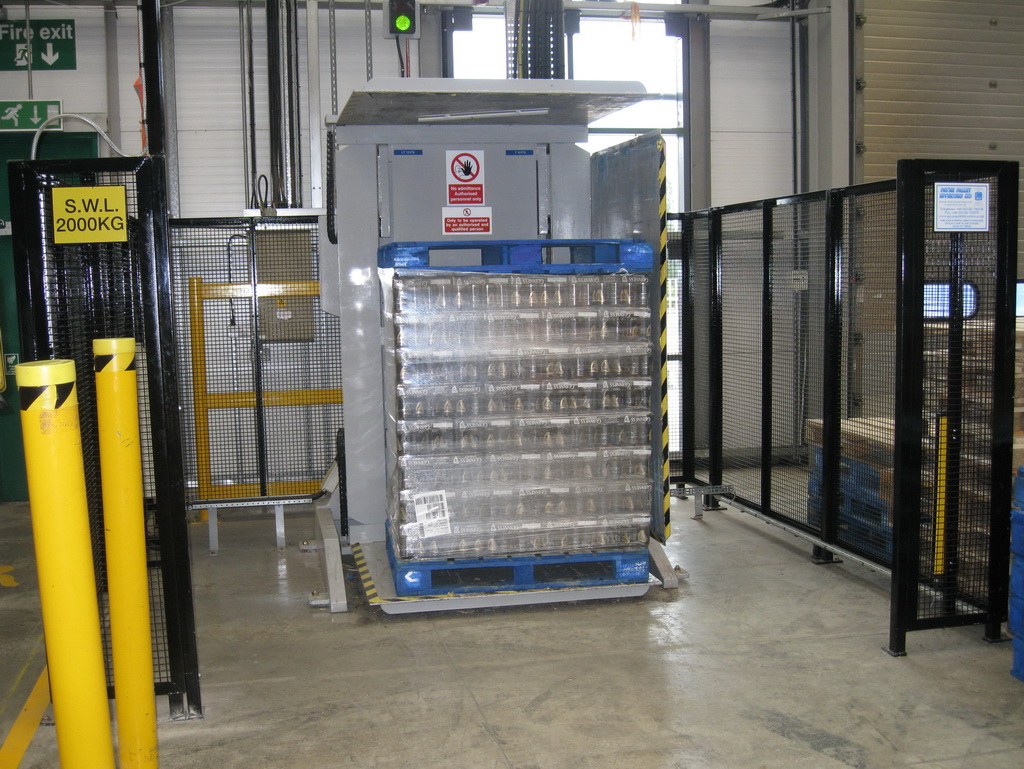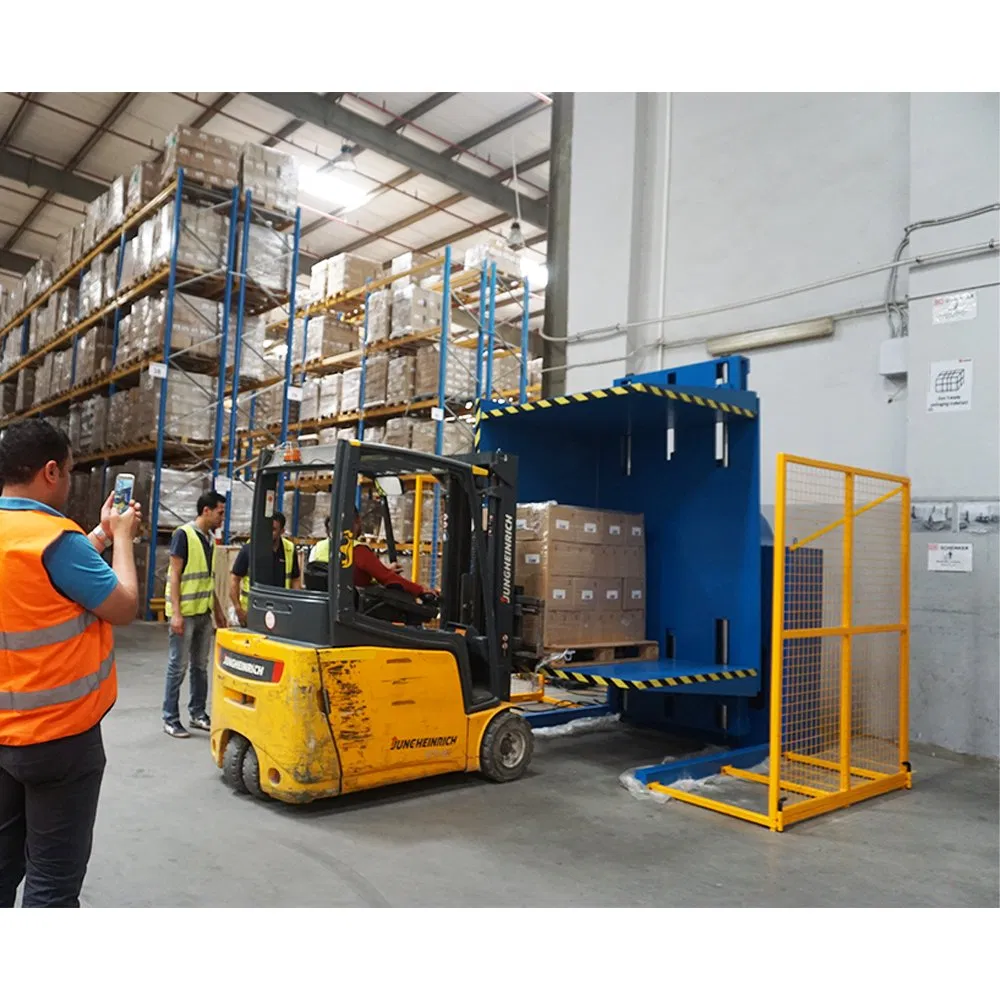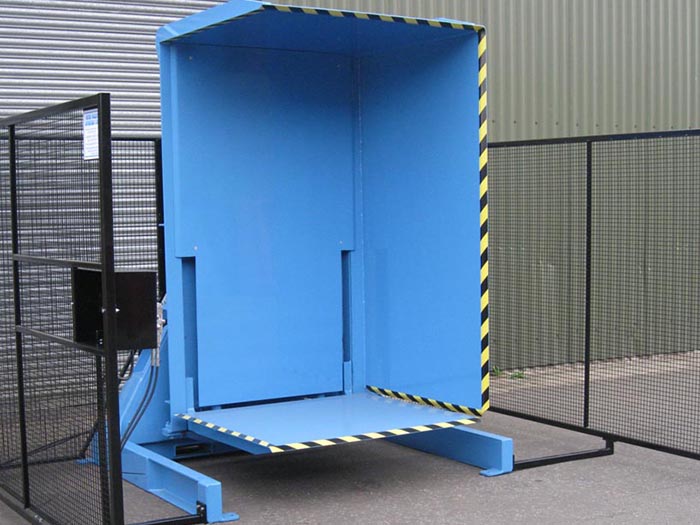From Manual to Smart: Pallet Inverters Transforming Brazil's Material Handling
In my years in the packaging machine industry, I have seen many factories struggle with the same hidden problems. In Brazil's busy manufacturing and logistics sectors, manual pallet handling is a common sight. But it is also slow, dangerous, and a major source of product damage. These issues are not small details. They are hidden costs that slowly eat away at your profits and your ability to compete. Think about the reports of worker injuries from heavy lifting. Think about the pallets of goods that get dropped and wasted. Think about the production bottlenecks in your shipping bay that delay orders. For a leader in a demanding industry like steel, these problems directly impact the bottom line. But there is a powerful solution. Smart pallet inverters automate this entire process. They introduce speed, safety, and efficiency, completely transforming your material handling workflow from a liability into an asset.
Pallet inverters are transforming Brazil's material handling by replacing slow, labor-intensive manual processes with automated, efficient systems. This fundamental shift boosts productivity, greatly enhances worker safety, and reduces costly product damage. This allows Brazilian companies in sectors from food processing to heavy industry to become more agile and competitive on the global stage.

This change from manual labor to smart automation might seem like a huge leap. I understand that. As an engineer and a factory owner, I always look at the practical side of things. You are probably wondering how this technology really works. You might be asking if it is the right fit for your specific operation and if the investment makes financial sense. These are the right questions to ask.
Let's break it down together. In this article, I will use my experience to explore how these machines can solve real-world problems. We will look at the direct financial benefits, the critical safety improvements, and how to choose the right system for your specific needs, especially in demanding environments like the steel industry.
How can pallet inverters directly reduce operational costs and improve ROI?
Are rising labor costs, material waste, and fluctuating energy prices squeezing your profit margins? I see this challenge with clients all the time. Manual handling of goods often leads to damaged products and slow, inefficient cycle times. Each of these issues is a direct hit to your company's profit. You might not see it as one big line item on a report, but it adds up every single day. The good news is that pallet inverters provide a clear and measurable path to reducing these costs and improving your financial performance.
Pallet inverters directly reduce operational costs by minimizing the need for manual labor for pallet exchange, drastically cutting down on product damage during handling, and speeding up the entire logistics process from production to shipping. This combination of savings and increased throughput leads to a fast and strong return on investment (ROI).

To understand the full impact, we need to look deeper than just the machine's price tag. The true value is in the day-to-day operational changes it brings. For a practical business leader like a steel mill owner, the numbers have to make sense. So, let's analyze how the savings are generated and how you can calculate the potential return for your own facility.
A Deeper Look at Cost Reduction
The cost savings from a pallet inverter come from several key areas. When you add them all up, the financial argument becomes very compelling.
- Reduced Labor Costs: A manual pallet exchange might require two or even three workers. They spend time positioning the pallets, manually unstacking and restacking goods, and coordinating with a forklift driver. A pallet inverter requires only one operator, who can often manage the entire process in a fraction of the time. This frees up your other workers for more value-added tasks.
- Lower Product Damage: Manual handling is risky. Boxes get dropped, bags tear, and containers can be punctured. A pallet inverter uses a gentle and controlled clamping and rotation system. It secures the load before turning it, virtually eliminating the risk of spills and damage. I remember a client in the chemical industry who was losing thousands of dollars a month from torn bags. The inverter solved that problem overnight.
- Optimized Pallet Management: Many companies ship products on cheap, one-way wooden pallets. But they use more durable and expensive plastic or metal pallets for in-house use. A pallet inverter makes it fast and easy to switch loads from your high-quality internal pallets to low-cost shipping pallets right before loading a truck. This protects your investment in expensive pallets and lowers your shipping costs.
Here is a simple table to visualize the impact:
| Cost Category | Manual Handling | With Pallet Inverter | Savings |
|---|---|---|---|
| Labor | 2-3 Workers | 1 Operator | 50-65% Reduction |
| Product Waste | 1-3% of Handled Goods | <0.1% of Handled Goods | 90%+ Reduction |
| Pallet Costs | Risk of losing expensive pallets | Use cheap pallets for shipping | Significant Savings |
Calculating Your Return on Investment (ROI)
An investment in new equipment must be justified by a clear return. The ROI for a pallet inverter is usually straightforward to calculate.
A simple formula is:
ROI = (Total Annual Savings - Cost of Investment) / Cost of Investment
Let's imagine a scenario for a medium-sized Brazilian warehouse:
| Item | Cost / Savings (Annual) | Notes |
|---|---|---|
| Investment Cost | - R$ 150,000 | Includes machine, shipping, installation |
| Labor Savings | + R$ 120,000 | Reassigning 1.5 workers |
| Reduced Waste | + R$ 45,000 | Saving R$ 3,750 per month in damaged goods |
| Pallet Savings | + R$ 20,000 | Preventing loss of in-house pallets |
| Total Annual Savings | + R$ 185,000 | |
| Payback Period | ~9.7 Months | (150,000 / 185,000) * 12 |
I once worked with a steel wire manufacturer who was very skeptical at first. He trusted his team and his old processes. But after we sat down and ran the numbers for his specific operation, he saw the payback period was less than 18 months. He told me later, "Vincent, I'm a numbers guy. I couldn't ignore that." That is the power of a solid ROI analysis.
What are the key safety and efficiency gains from automating pallet exchange?
Is your factory's safety record a constant source of worry? Is your team's well-being a top priority? Manual lifting of heavy and awkward loads is one of the leading causes of workplace injuries, especially back problems. These accidents are terrible for your employees. They also halt production, increase insurance costs, and damage morale. At the same time, these manual processes create bottlenecks that limit your factory's true potential. Automating pallet exchange with an inverter directly addresses both of these critical issues.
The key safety gain from automating pallet exchange is the significant reduction in manual handling, which minimizes musculoskeletal injuries among workers. The primary efficiency gain comes from creating faster, more consistent cycle times. This combination eliminates production bottlenecks and boosts overall plant productivity and throughput.

Safety and efficiency are two sides of the same coin. A safe process is often an efficient one because it is smooth, predictable, and controlled. Let's dive deeper into how pallet inverters deliver major improvements in both of these areas, transforming the work environment and the production flow.
Creating a Much Safer Work Environment
The most immediate impact of a pallet inverter is on worker safety. The machine takes on the most dangerous part of the job: lifting and moving a heavy load.
- Eliminating Dangerous Lifts: A fully loaded pallet can weigh over 1,000 kg. Manually transferring goods from one pallet to another, even box by box, involves repetitive bending, lifting, and twisting. This is a classic recipe for back injuries, shoulder strain, and other musculoskeletal disorders. A pallet inverter does all the work. The operator simply loads the pallet with a forklift or pallet jack and pushes a button.
- Controlled and Secure Operation: A pallet inverter clamps the load securely from the top and bottom before it begins to rotate. This prevents any shifting or falling, which can be a major hazard with unstable loads. Modern machines are also equipped with critical safety features.
- Safety Fencing: This creates a physical barrier around the machine's operating area, preventing anyone from accidentally walking into the path of the moving parts.
- Light Curtains: These are infrared beams that, if broken by a person or object, will instantly stop the machine's movement.
- Reducing Worker Fatigue: Manual labor is physically draining. As workers get tired, their movements become less precise, and the risk of accidents increases. An automated system performs the same way on the last hour of a shift as it does on the first. This consistency is a key part of building a strong safety culture.
Unlocking New Levels of Efficiency
A safer process is also a faster and more reliable one. By removing manual variability, you introduce predictability and speed into your workflow. This is essential for meeting ambitious production goals, like achieving 95% equipment uptime.
- Drastic Cycle Time Reduction: A manual pallet exchange can take anywhere from 10 to 30 minutes, depending on the load. A pallet inverter can complete the same task in about 60-90 seconds. This difference is massive.
| Process Step | Manual Exchange | Pallet Inverter |
|---|---|---|
| Positioning Pallets | 2-3 minutes | 30 seconds |
| Transferring Goods | 5-25 minutes | N/A |
| Rotation/Inversion | N/A | 30 seconds |
| Removing Pallets | 2-3 minutes | 30 seconds |
| Total Time | 10-30+ minutes | ~1.5 minutes |
- Eliminating Bottlenecks: In many factories, the shipping department is a major bottleneck. Products are ready, but the process of preparing them for shipment is slow. Trucks and drivers are left waiting, which can lead to detention fees and strained relationships with logistics partners. By speeding up pallet exchange, an inverter can help clear this bottleneck and improve the flow of your entire operation. I had a client in São Paulo who ran a large distribution center. They told me that after installing a pallet inverter, they could load trucks 30% faster. This was a game-changer for their daily schedule.
How do pallet inverters integrate into a digitally transformed, smart factory?
Are you investing in building a "smart factory"? Are you implementing systems like MES or ERP to get a better handle on your production data? It's a powerful vision. But this vision can be undermined by "islands" of manual processes that create data black holes. If you can't see or measure a part of your process, you can't control or optimize it. Manual pallet handling is often one of these hidden black holes. It happens off the books, with no data trail.
Pallet inverters integrate into a smart factory by acting as a connected data node. They can be equipped with IoT sensors and PLC controls that link directly to a central Manufacturing Execution System (MES). This provides real-time data on cycle times, load counts, and machine status, enabling full production visualization and supporting data-driven decisions.

A truly smart factory connects every step of the process. A pallet inverter is not just a piece of mechanical equipment; it's a bridge that connects the physical movement of your goods to your digital management systems. Let's explore how this integration works and the powerful capabilities it unlocks.
The Pallet Inverter as a Data Hub
The brain of a modern pallet inverter is its Programmable Logic Controller (PLC). This is the same technology that runs your most complex production machinery. This PLC can be programmed to communicate with other systems and can be connected to various sensors.
- IoT Sensor Integration: We can equip a pallet inverter with sensors that capture critical operational data. These can include optical sensors to count the number of pallets processed, load cells to weigh each pallet, and internal diagnostics to monitor the health of the machine's motors and hydraulic systems.
- Connecting to MES/ERP: This captured data is then sent from the inverter's PLC to your central factory software. Instead of an operator manually logging that a pallet was switched, the system logs it automatically, instantly, and accurately. Your production dashboard now reflects the reality on the factory floor in real-time. This is the foundation of full production visualization.
Enabling Predictive Maintenance and Smart Scheduling
Collecting data is only the first step. The real power comes from using that data to make smarter decisions. This is where a pallet inverter helps you achieve advanced goals like predictive maintenance and intelligent production scheduling.
- Predictive Maintenance: The inverter can track its own usage—number of cycles, operating hours, motor temperature. By analyzing this data over time, your maintenance system can predict when a component is likely to need service before it fails. This prevents unexpected breakdowns and costly downtime. It helps you move from a reactive "fix it when it breaks" model to a proactive, planned maintenance strategy. This is crucial for hitting a high target like 95% equipment uptime.
- Intelligent Scheduling: When your MES knows exactly how long the pallet inversion step takes, it can create a much more accurate and efficient overall production schedule. The system understands the capacity and speed of this critical logistics step and can plan upstream and downstream activities accordingly. This ensures a smooth, continuous flow of materials and finished goods through the plant.
This table shows how the pallet inverter fits into the smart factory ecosystem:
| Smart Factory Feature | Pallet Inverter's Contribution | Benefit for Management |
|---|---|---|
| IoT Connectivity | Captures cycle time, pallet count, weight, machine status. | Provides real-time visibility into the logistics process. |
| MES Integration | Automatically sends operational data to the central system. | Ensures accurate, up-to-the-minute production tracking. |
| Data Analytics | Provides historical performance data for analysis. | Helps identify bottlenecks and enables predictive maintenance. |
| Full Automation | Connects to AGVs, robotic palletizers, and conveyors. | Creates a fully automated, "lights-out" logistics workflow. |
Which pallet inverter is right for heavy industries like steel manufacturing?
Do you believe that pallet inverters are only designed for lightweight goods like food, beverages, or pharmaceuticals? I have heard this before. But the reality is that the extreme weight, rough surfaces, and harsh conditions of a steel mill simply require a different class of equipment. Choosing a standard, light-duty machine for a heavy industrial application is a recipe for failure and a costly mistake. It will not stand up to the demands.
For heavy industries like steel manufacturing, the right choice is a heavy-duty, floor-level pallet inverter with a high load capacity, typically 2,000 kg or more. It must be built with a reinforced steel frame, powerful hydraulics, and a robust, adjustable clamping system to safely handle dense and often unstable loads like steel coils, engine blocks, or stacks of metal parts.

In my career, I've spent countless hours on the factory floors of steel mills and metal fabrication plants. I understand the environment. It's dusty, it's noisy, and the equipment has to be tough. A machine that performs well in a cleanroom will not survive here. So, let's break down the specific features to look for and compare the types of inverters that are best suited for these demanding jobs.
Key Features for Heavy-Duty Applications
When you are evaluating a pallet inverter for a steel mill or similar environment, you need to look past the marketing materials and focus on the engineering.
- High Load Capacity: This is non-negotiable. While a standard inverter might handle 1,000-1,500 kg, a heavy-duty model must start at 2,000 kg and go up to 3,000 kg or even more. Always choose a capacity that is significantly higher than your heaviest typical load to ensure a margin of safety.
- Robust Construction: The machine's frame should be made from thick, reinforced steel. All welds must be solid and clean. The hydraulic and electrical components should be well-protected from dust, moisture, and potential impacts from forklifts. A durable, industrial-grade paint finish is also important to prevent corrosion.
- Powerful Clamping System: Handling a heavy load is one thing; holding it securely while it is turned upside down is another. Look for a machine with a powerful hydraulic clamping system. The clamping plates should be large and ideally have adjustable pressure. This allows you to secure a heavy, dense load like a stack of steel plates without damaging a softer load like a bulk bag of material.
- Floor-Level Loading: In most industrial settings, the easiest and safest way to load a pallet inverter is directly from the floor. This allows a standard forklift or even a simple hand pallet jack to place the load into the machine. It is much more versatile than models that require a raised platform or a specific loading height.
Comparing Inverter Types for a Steel Mill
Not all inverters are the same. The right model depends on your specific application within the mill.
| Inverter Type | Best Use Case in the Steel Industry | Pros | Cons |
|---|---|---|---|
| 180° Floor-Level Inverter | Transferring finished goods (like stacked parts, castings, or bagged materials) from an in-house pallet to a shipping pallet. | Very robust, high capacity, easy to load with a forklift. The most versatile option. | Requires a moderate amount of floor space. |
| 90° Tipper / Tilter | Tipping heavy steel coils or large single components from vertical to horizontal for inspection or processing. | Can handle extremely heavy and large loads. Simple, powerful mechanism. | It is not a full pallet exchange solution; it only tilts the load. |
| Inline Conveyorized Inverter | Used in fully automated, high-volume production lines for standard products (e.g., brake discs, small castings). | Highest possible throughput. Integrates seamlessly with AGVs and conveyors. | Highest initial investment and complexity. |
My experience has taught me that a standard, off-the-shelf machine will not last in a steel mill. It's why I started SHJLPACK—to build machines for the real world. We build our heavy-duty inverters like tanks. It is not just about being able to lift the weight. It is about being able to do it safely and reliably, thousands of times, in a tough environment. This is where a strategic partner who understands your industry is far more valuable than a simple supplier.
My Insights
My journey from an engineer on the factory floor to a business owner taught me one key lesson: technology is a tool, not a magic wand. For a leader like Javier Morales, who runs a massive steel operation, the real value is not just in buying a machine. The value is in finding a partner who truly understands the challenges—the constant pressure of energy costs, the reality of aging equipment, and the absolute need for a solid return on any investment.
When we talk about introducing pallet inverters to the dynamic markets in Brazil or Mexico, we are not just talking about flipping pallets. We are talking about making a strategic move that addresses those core business challenges head-on.
- It fights cost volatility: By reducing your reliance on manual labor and cutting down material waste, it gives you more control and predictability over your operational costs. This is a powerful defense against market fluctuations.
- It is a smart, targeted upgrade: You do not need to replace your entire production line. An inverter modernizes a single, critical point in your logistics chain, immediately delivering improvements in efficiency and reliability that ripple through your whole operation.
- It is a bridge to your digital future: This machine is not an isolated piece of metal. It is a data-gathering point that connects a fundamental physical process to your smart factory goals, giving you the visibility you need to manage effectively.
My advice to any industrial leader is to always look beyond the initial price tag. Ask the hard questions. Ask about the thickness of the steel used in the frame. Ask about the brand of the hydraulic pump and motors. Ask about the availability of spare parts and the plan for after-sales support. A true partner will have these answers ready because they have built the machine with your reality in mind. That is the entire philosophy I built SHJLPACK on—sharing our knowledge to help you make the right choice for your business, not just to make a sale.
Conclusion
In summary, adopting smart pallet inverters is a strategic move for Brazilian industries, boosting efficiency, safety, and profitability while supporting critical digital transformation goals for a more competitive future.




